Twinhead U12C Notebook PC User Manual U12C UserMan
Twinhead International Corporation Notebook PC U12C UserMan
Twinhead >
(U12C) UserMan

U
Us
se
er
r’
’s
s
M
Ma
an
nu
ua
al
l

Table of Contents
i
Table of Contents
CHAPTER 1 ...........................................................................................................1
INTRODUCTION..................................................................................... 1
Getting Started ...........................................................................................2
Inventory ....................................................................................................3
Safety and Maintenance .............................................................................4
Checklists ...................................................................................................5
Features......................................................................................................6
Where to Look For Information .................................................................6
Quick Start..................................................................................................7
Loading Windows.......................................................................................8
Adjusting the Volume..................................................................................9
Adjusting the Brightness.............................................................................9
Turning off Your Computer......................................................................10
Making a Startup Disk..............................................................................10
Tips for New Owners................................................................................11
CHAPTER 2 .........................................................................................................13
GETTING STARTED............................................................................. 13
Hardware and Software ...........................................................................14
Front View................................................................................................15
Rear View.................................................................................................17
Right View................................................................................................17
Bottom View .............................................................................................18
LED Status Indicators ..............................................................................19
Power Indicators......................................................................................19
Function Keys...........................................................................................20
Numeric Keypad.......................................................................................20
Touchpad..................................................................................................20
Connecting the Printer.............................................................................22
Smart Card (Integrated Circuit Card) Reader.........................................22
The Graphics System................................................................................23
CHAPTER 3 .........................................................................................................28
MAKING CONNECTIONS...................................................................... 28
Making Connections.................................................................................29
Left Side Connectors ................................................................................29
Right Side Connectors (Optional) ............................................................30
Rear Side Connectors...............................................................................31
CHAPTER 4 .........................................................................................................32
POWER MANAGEMENT ....................................................................... 32

Table of Contents
ii
Power Management..................................................................................33
Monitoring Battery Power........................................................................34
Power Saving Modes................................................................................35
Power Saving Tips....................................................................................36
When to Replace the Battery ....................................................................37
Heat Considerations.................................................................................37
CHAPTER 5 .........................................................................................................39
USING THE BIOS SETUP UTILITYUSING THE BIOS SETUP UTILITY .39
USING THE BIOS SETUP UTILITY .................................................... 40
Main Menu ...............................................................................................40
Advanced Menu........................................................................................41
Boot Menu ................................................................................................42
Security Menu...........................................................................................44
Exit Menu .................................................................................................45
APPENDIX A........................................................................................................46
INSTANT RECOVERY SOFTWARE ........................................................ 46
APPENDIX B........................................................................................................60
FAQ & STATEMENT........................................................................... 60
Frequently Asked Questions.....................................................................61
Statements.................................................................................................63
European Notice.......................................................................................64
SAFETY CAUTION..................................................................................65
Canadian Department of Communications..............................................65
Battery Disposal.......................................................................................66
CAUTION FOR ADAPTER......................................................................66
BATTERY CAUTION ...............................................................................66
CLASS 1 LASER PRODUCT....................................................................66

C
Ch
ha
ap
pt
te
er
r
1
1
I
In
nt
tr
ro
od
du
uc
ct
ti
io
on
n

Chapter 1
2
Getting Started
Congratulations on your purchase of the Notebook computer! Your
new notebook features the most innovative advances in portable
computing technology. It combines state-of-the-art ergonomics with
sophisticated architecture to provide you with a personal computer that
is compact, powerful, and easy to use. Designed for a wide range of
general, business, and personal productivity applications, the
notebook is an ideal choice for use in the office, at home, and on the
road.
For maximum expandability without compromising portability, the
notebook accommodates a number of modules, including Optical
Drive, three USB ports, one Express card and one 4 in 1 card slot. The
high capacity hard disk drive provides you with plenty of storage space
for multimedia files and applications.
This Manual contains all the information you need to set up and use
your new notebook. It describes all the features of the notebook in an
easy-to-read yet thorough manner.

Chapter 1
3
Inventory
This computer system is designed for years of productive and
pleasurable computing. Use this section to keep details of your
purchase. This information will be required should you need to make
repairs to your notebook during the warranty period. Update this
section when you add new options.
DATE OF PURCHASE:
PLACE OF PURCHASE:
DEALER'S NAME:
DEALER'S ADDRESS:
TELEPHONE:
E-MAIL ADDRESS/WWW:
CONTACT PERSON:
MODEL NUMBER:
SERIAL NUMBER:
BIOS VERSION:
The serial number is on the label (with a bar code) on the bottom side
of the computer. The BIOS revision number will appear briefly on the
screen after turning on the computer, before the graphic BIOS screen
appears. Press the Del key to enter BIOS setup screen.

Chapter 1
4
Safety and Maintenance
You can use your computer under a wide range of environmental
conditions. However, to ensure long use and continued high
performance, consider the following factors when setting up your
computer:
• Follow all warnings and instructions noted in this documentation
and in the Windows Help program.
• The first time you use your computer, we recommend that you
carefully read the Making Connections section of this manual
and initialize the battery to ensure optimum battery performance.
• Unplug the computer from the power outlet before cleaning. Use
a damp cloth for cleaning. Do not use aerosols, solvents, or
strong detergents.
• Do not use the computer near open water or other liquids. Never
spill liquid onto the computer.
• Do not place the computer in an unstable location where it might
slip or be knocked over. Serious damage could result from a fall.
• Slots and openings in the system cabinet are for ventilation
purposes. Do not block or cover these openings or the system
could overheat. Do not use or store the computer near a source
of heat or dust.
• On the base or rear panel of this notebook, there is a label with
information on the power requirements of this system. These
requirements must be followed. If you are unsure of your local
power supply, consult your dealer or local Power Company.
• Do not step on or place anything on the power cord.
• If you use the computer with an extension cord, ensure that the
total ampere ratings of all the devices sharing the extension do
not exceed the rating of the extension cord or the rating of the
wall outlet.
• Never push foreign objects into the computer through any of the
slots or openings. Dangerous voltages are present, which could
cause electric shock or fire, or damage sensitive components.
• For best results, use a power strip with a built-in surge protector.
Do not use inferior extension cords as this may result in damage
to your computer.

Chapter 1
5
• Set the computer on a flat, stable surface. To prevent damage to
the computer’s hard disk drive, avoid using the computer where
it will be exposed to strong vibration.
Checklists
After opening the package, carefully inspect the contents. If any of the
items is missing or appear damaged, contact your dealer. The
shipping carton should contain the following:
STANDARD
A notebook computer with a hard disk drive
An internal battery
An Optical drive
An AC adapter with power cord
OPTIONS
The following items are normally optional, but some vendors may
include them in the standard package. Some items may not be
available in some countries, or some vendors may choose not to carry
all the items.
2GB or 4GB DDRIII SODIMM memory cards
CAUTION:
When purchasing any of the accessories listed above, purchase
only those accessories that are approved for use with your
computer. The above accessories are proprietary items. Your
system vendor can obtain these approved accessories. If you
use items that are not approved for use with this computer, you
may cause your computer to malfunction, or to emit or receive
electro-magnetic radiation in excess of local regulations. For
non-proprietary accessories such as PC cards or printers,
ensure that the accessory functions properly in your computer
before making the purchase. Your system vendor may be able to
recommend reliable brands and models.

Chapter 1
6
Features
High Capacity Hard Disk Drive
The computer has a high capacity hard disk drive, to store your favorite
programs and large multimedia files.
Built-in Modem/LAN Capability
A built-in 56k modem and 10/100/1000 Mbps Ethernet port allows you to
access the Internet or a local area network (LAN).
LCD
Your computer has an easy-to-view WXGA or WXGA+ LCD panel.
Built-in Stereo Speakers and Microphone
The stereo speakers and internal microphone enable you to run a variety of
multimedia applications.
Convenient Audio Control
The conveniently located audio control knob enables you to easily adjust
the volume to the stereo speakers.
Where to Look For Information
About Your Computer
This User’s Manual describes the key elements of your computer. New
users can find a simple step-by-step orientation in the Quick Start section
of this chapter.

Chapter 1
7
Quick Start
Turning on the Computer for the First Time
1. Connect the AC adapter
power cord to the AC
adapter.
2. Connect the AC adapter
to the DC power port on
the left side of your
computer.
3. Connect the AC adapter
power cord to an AC
outlet.
4. Slide the cover latch in
the direction of the
arrows to open the LCD.
5. Open the LCD panel to a
comfortable viewing
angle.
6. Press the power button
to turn on the power.
Note: The battery is not fully charged. Allow
your battery to fully charge before using it
(i.e., before disconnecting AC power).
Calibrating the battery before use is also
highly recommended. Refer to Chapter 5,
Power Management, for further information.
Use the touchpad to move the cursor on the screen. Move your finger
across the pad to control the cursor, and press the right and left
buttons beneath with your thumb. These buttons have the same
functions as the right and left buttons of a standard mouse. You can
also click or double-click by tapping on the touchpad.
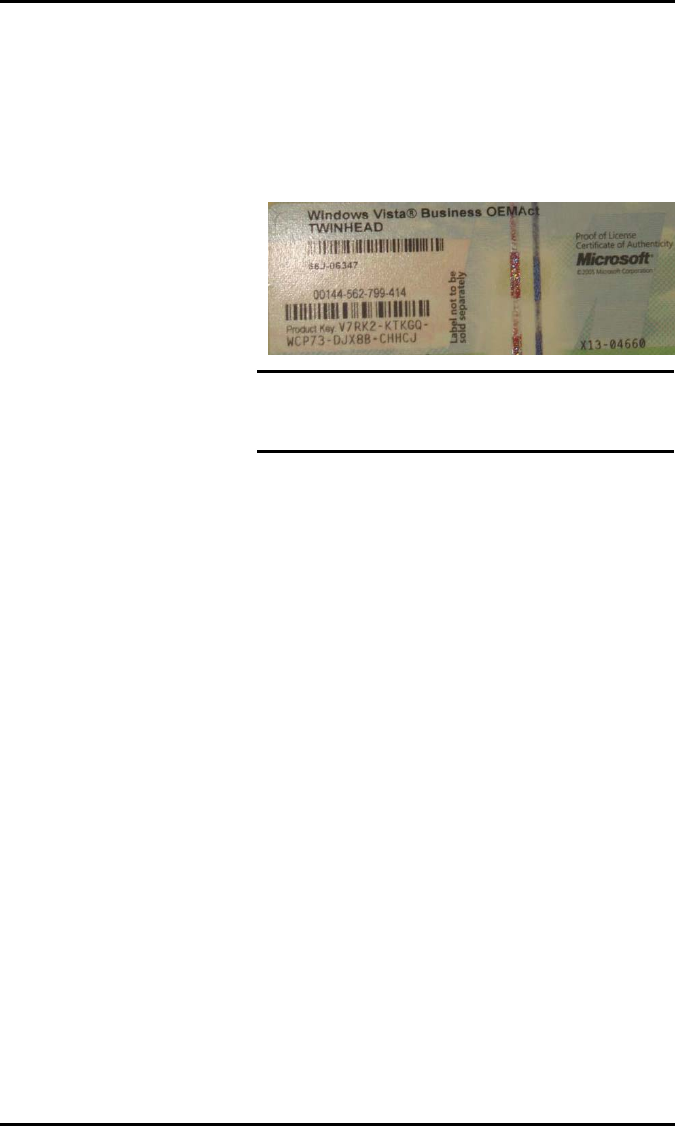
Chapter 1
8
Loading Windows
The following section is for installing the Windows operating system
only. If you are installing a different operating system, please check
with your vendor for installation details.
Your computer will begin
loading Windows once
you turn on the power.
Wait a few seconds for
Windows setup to load.
The Windows setup will
prompt you for the
product key number,
shown to the right: Note: The product key is on a sticker
attached to the bottom of the Notebook.
Type your name, and, if applicable, the name of your company.
Read the End User's License Agreement. Click Next to accept it.
Enter the product key number. You can find this on the Certificate of
Authenticity on a sticker attached to the computer. Click Finish.
The Start Wizard will prompt you to set the date, and your local time.
After the Start Wizard updates your system settings, the Welcome to
Windows screen will appear. You may disable this feature by clearing
the check box labeled show this screen each time Windows starts.
Some software comes preloaded with Windows. New users can
familiarize themselves with this software by selecting Programs from
the start menu, then clicking on programs to run them.
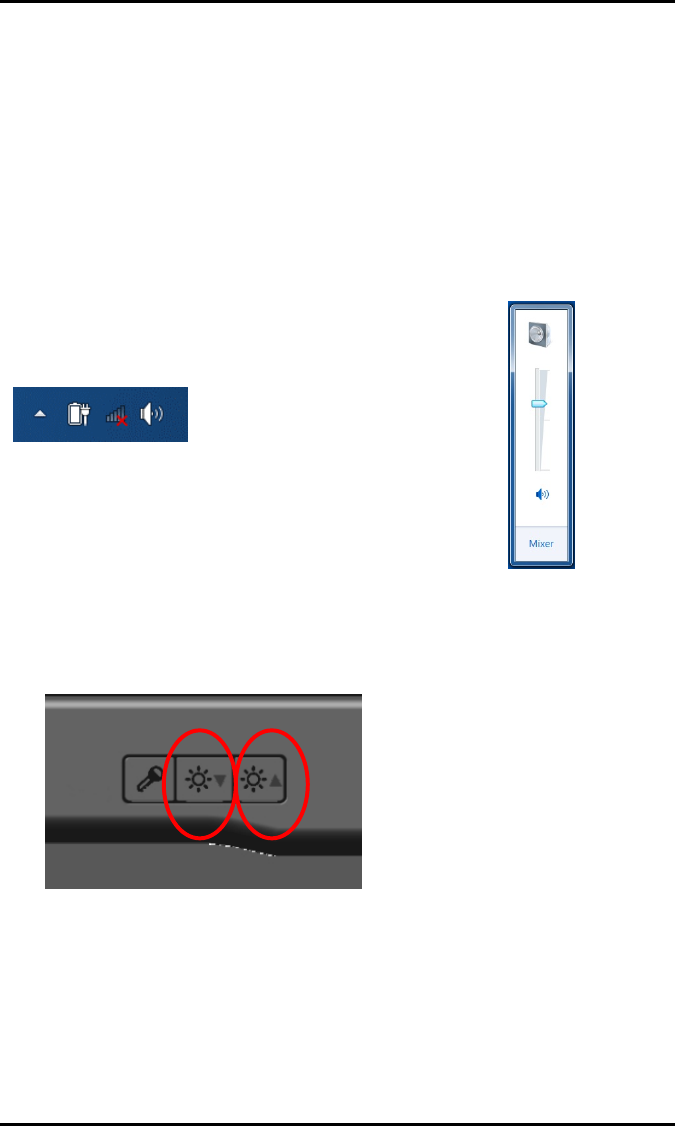
Chapter 1
9
Adjusting the Volume
You can adjust the volume with hot key combination as below:
• Fn + F8 decreases the volume
• Fn + F9 increases the volume
• Fn + F10 Mute the volume
Alternatively, you can adjust the volume
with the Windows volume control applet
located on the taskbar.
Adjusting the Brightness
Use the following hot key to adjust the LCD panel brightness:
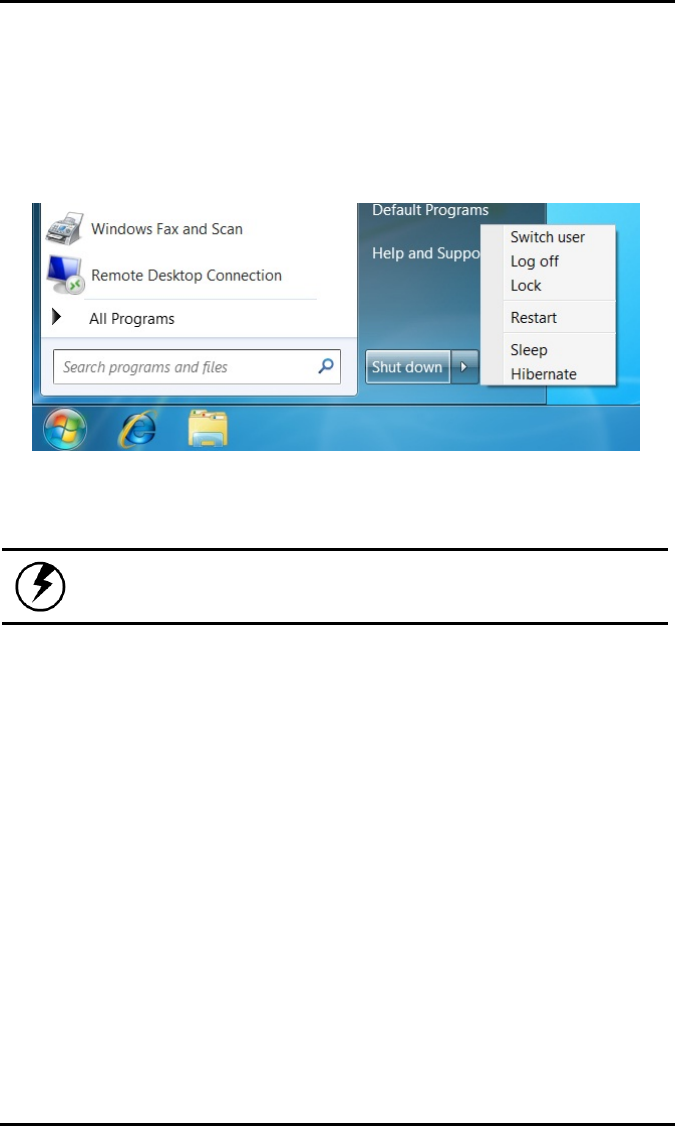
Chapter 1
10
Turning off Your Computer
Turning off the computer properly is important to maintaining your
computer.
1. On the Start menu. 2. Click Shut down
If you are going to be away from the computer for a short period, there
are ways of conserving power without shutting down the system. See
Chapter 4, Power Saving Modes, for details.
Warning: Shutting off the computer improperly may result in data loss.
Making a Startup Disk
If you have trouble starting Windows, the startup disk can be used to
start your computer and fix many problems. Refer to the Windows user
manual for instructions.

Chapter 1
11
Tips for New Owners
Take responsibility for backup
Back up files often. Users who need to manage large amounts of data
may wish to use backup devices such USB drive. If you use your
notebook as a networked workstation with system backup, talk to the
system administrator about backup procedures for your notebook.
Don't leave passwords anywhere on your notebook or
carrying case
Be careful when placing your notebook on an airport
security conveyor belt
In most airports, security conveyor belts are safe for computers. If you
are not sure, ask the security staff. You should keep a close eye on
your computer. When you are in a hurry, make sure that you walk
away with the correct notebook computer!
Tape your business card to the notebook and accessories
In the workplace, notebooks and accessories may often look exactly
alike, leading to equipment mix-ups. Prevent such mix-ups by placing
your name on your equipment.
Develop ergonomic work habits
The science of ergonomics studies the relationship between health
and a suitable work environment. For more information on ergonomics,
contact your nearest computer bookstore, or local library. The Internet
also has information on this and other related subjects.

Chapter 1
12
Never take the notebook anywhere without the carrying
case
A broken screen or case can be costly to repair. Prevent accidents by
carrying the computer in a suitable carrying case.
Consider using a lock
For added security, consider purchasing a Kensington lock to put into
the Kensington lock hole on the back side of your computer. Use the
Kensington lock to secure the computer to a desk or table.
Note: Using a computer for extended periods of time with a poor
workstation setup and incorrect work habits can cause health
problems.

C
Ch
ha
ap
pt
te
er
r
2
2
G
Ge
et
tt
ti
in
ng
g
S
St
ta
ar
rt
te
ed
d

Chapter 3
14
Hardware and Software
This chapter introduces the different components and controls of your
notebook computer, including the hardware components, the software, and
the audio and video systems.
Getting Started
Before you begin using your computer, read this chapter to familiarize
yourself with the main components installed in the system. Lift the LCD
screen and open up the computer.

Chapter 3
15
Front View
1. Web CAM
2. Finger printer Reader
3. Quick button
4. LCD direction button
5. Program button
6. Slien button
7. LED Indicator
8. Brightness up
9. Brightness down
10. SAS button
11. Touchpad
12. Touchpad button
13. LCD latch
14. Handle
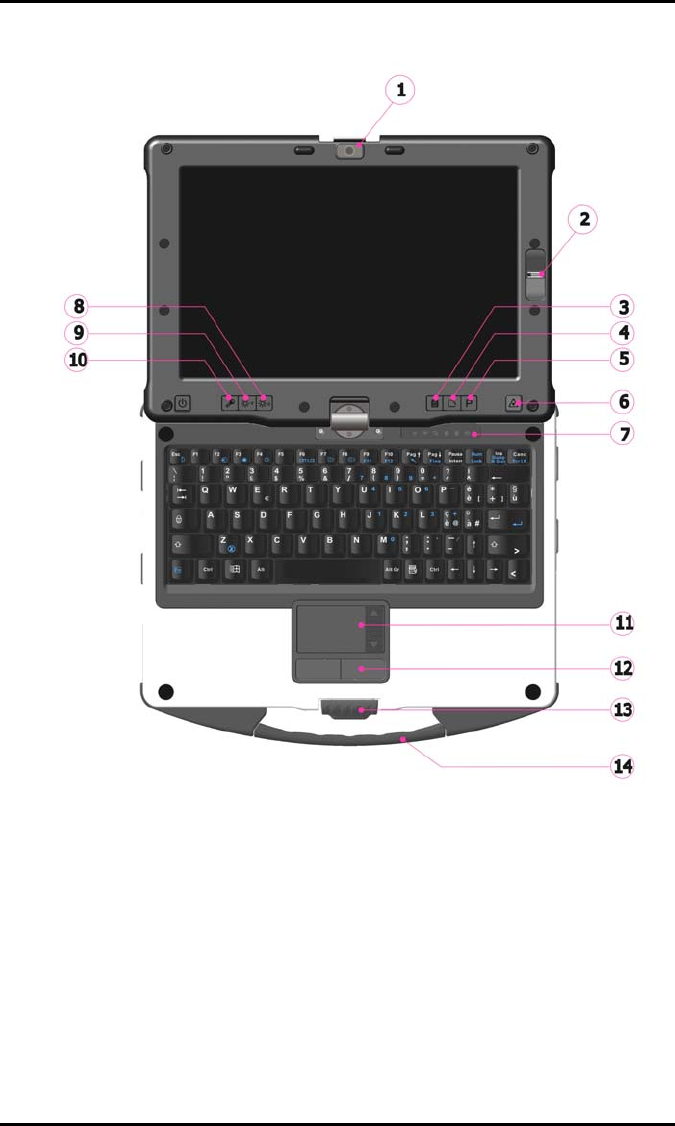
Chapter 3
16
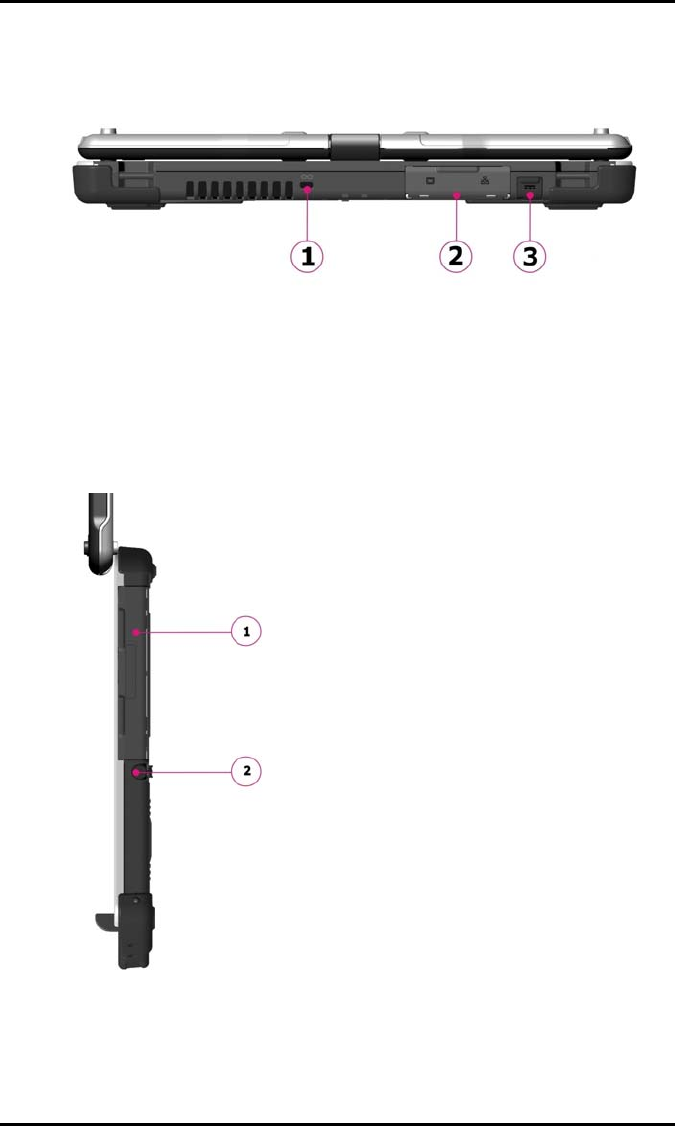
Chapter 3
17
Rear View
1. Kensington lock
2. VGA/Lan door
3. DC-in Jack
Right View
1. I/O door
2. Stylus
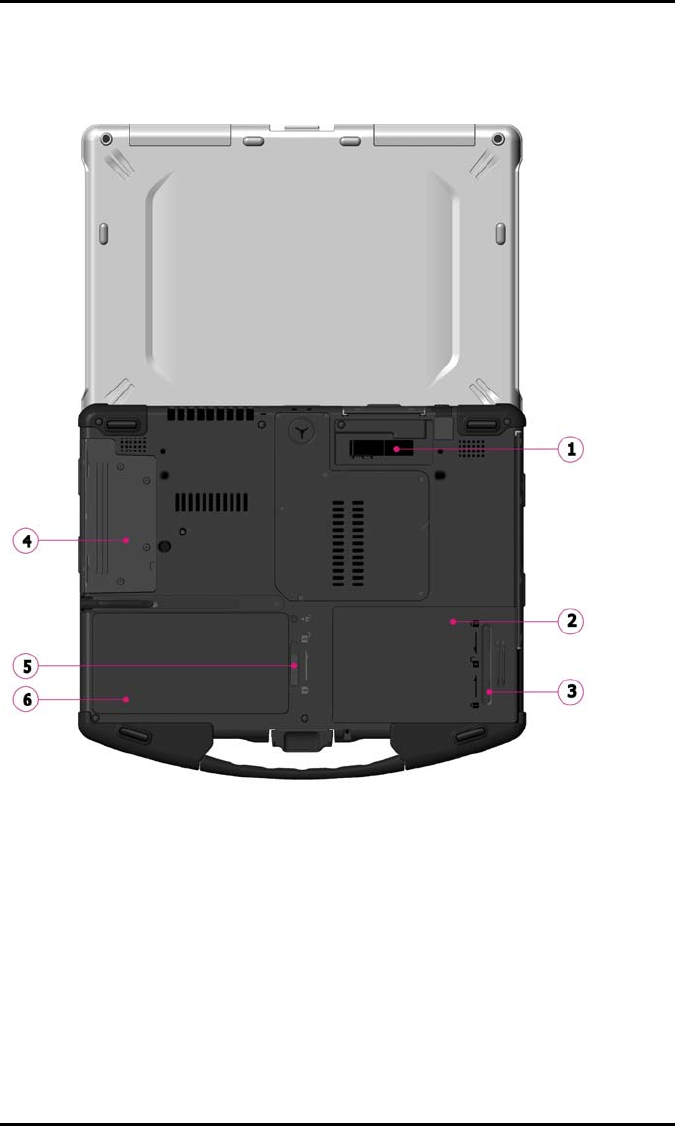
Chapter 3
18
Bottom View
1. Docking port
2. HDD cover
3. HDD Locker
4. I/O cover
5. Battery release latch with lock function
6. Battery cover
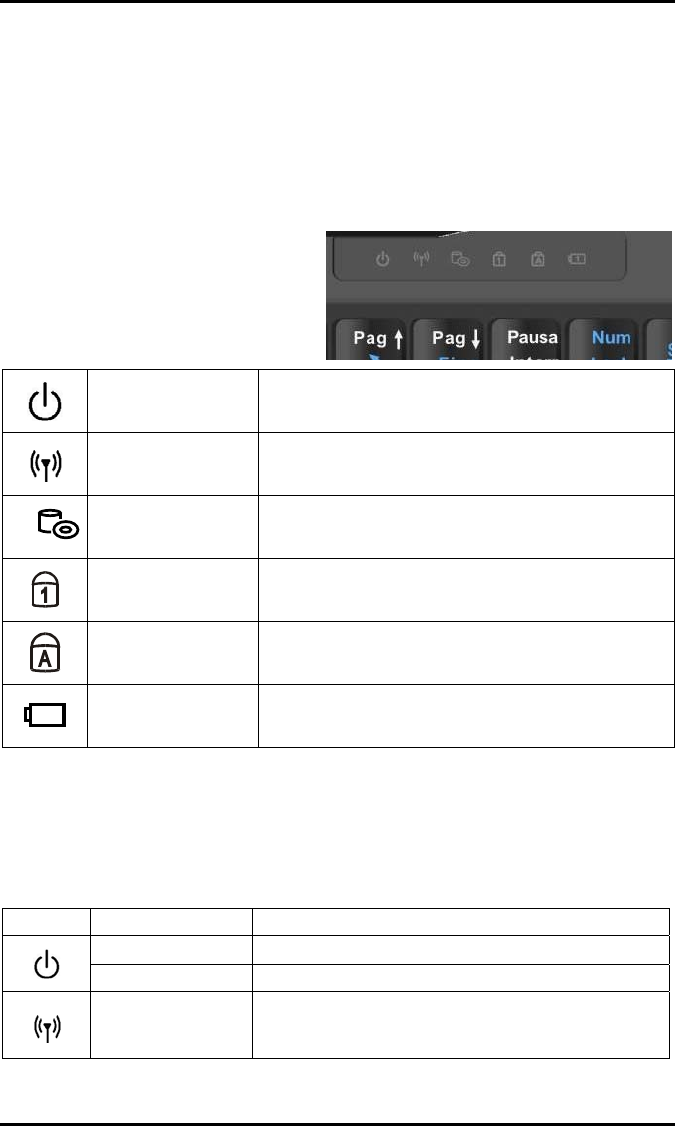
Chapter 3
19
LED Status Indicators
The status indicators in the upper left corner of the keyboard light up
when a particular function of the computer is active. Each indicator is
marked with a symbol.
Power indicator Power On/Off.
WLAN WLAN On/Off.
u.4 HDD/Optical Drive The computer is reading information from the optical
drive or HDD.
Number-Lock The keyboard is in Num-Lock mode.
Caps-Lock The keyboard is in Caps-Lock mode.
Battery Battery status.
Power Indicators
The power indicators show which power source the system is using. The
power indicators remain active and viewable even when the LCD panel is
closed.
Icon Light Description
Blue Power is on and the AC adapter is in use
Flash blue Power is in suspend mode
Blue RF
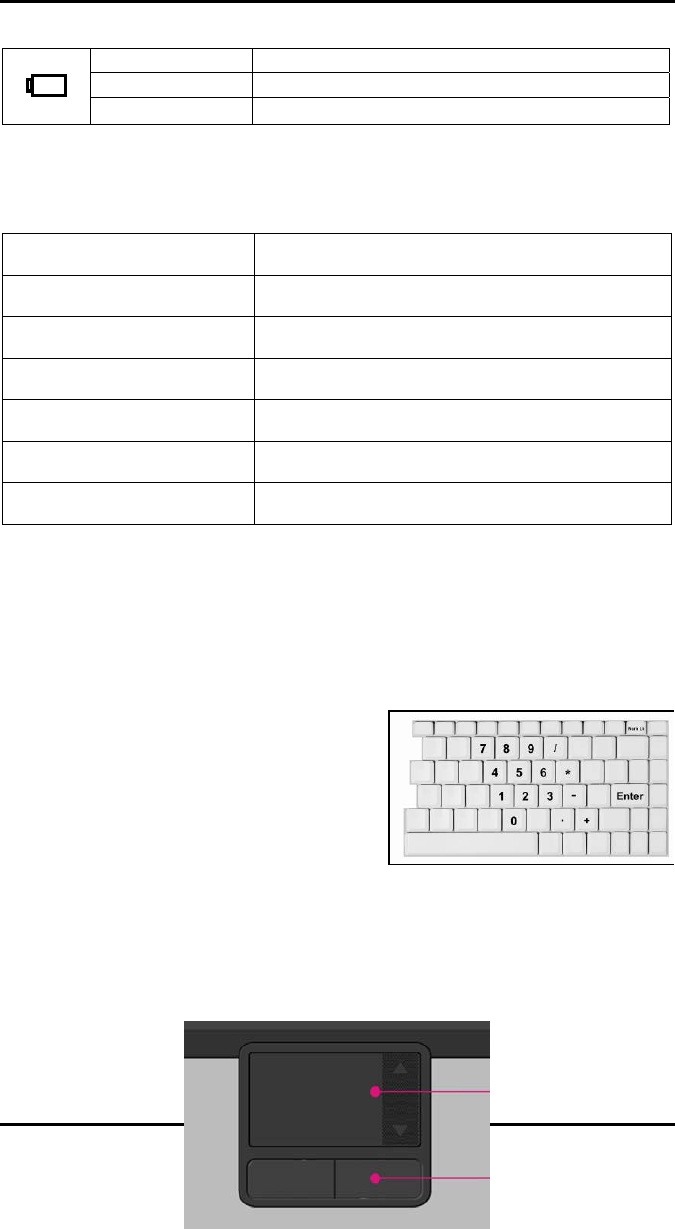
Chapter 3
20
Green Fully Charged
Orange Battery is charging
Flashing Orange Low battery
Function Keys
Hold the Fn key while pressing the numbered function key.
Function key Description
Fn + F3 Touch pad on/off
Fn + F4 Suspend Mode
Fn + F5 Toggles between LCD/CRT displays
Fn + F8 Volume decreases
Fn + F9 Volume increases
Fn + F10 Mute
Numeric Keypad
The embedded numeric keypad consists
of ten keys that make number intensive
input more convenient. Press <NumLock>
to enable or disable the numeric keypad.
Touchpad
The touchpad is a pressure sensitive pointing device that provides all the
features of a two-button mouse. Its primary function is to move the cursor
around the screen.

Chapter 3
21
The instructions listed below describe how to use the touchpad.
1. First, place your fingers on the keyboard in the normal typing
position. The touchpad is easily accessible by moving either your
left or right thumb off the space bar and on to the touchpad.
2. Gently move your thumb across the pressure-sensitive touchpad in
the direction you want the cursor to move. The pad detects the
change in pressure and moves the cursor in the corresponding
direction.
3. The touchpad offers another method of making selections in a
software program. It is called double-tapping. This function
corresponds to double-clicking with a mouse. Once the cursor
has been moved to the object you want to select, lightly double-
tap the pressure sensitive touchpad. This double-tapping on the
touchpad will select the desired item and prompt the software to
perform the related operation.
4. The buttons located directly below the touchpad are the same in
function as those on a two-buttoned mouse. Clicking these buttons
makes selections, drags objects, or performs a variety of other
functions depending on the software. To select an object, first move
the pointer over the object you want to select, and then press the
left button one time. The functions of these buttons are software
specific.
5. Double-clicking is a common technique for selecting objects or
launching programs from icons. Once you have moved the
pointer over the object you wish to select, rapidly press the left
button two times. This action is commonly referred to as “double-
clicking” an object.
Dragging
There are two ways to drag:
• Move the pointer to the desired location then press down the left
button. While still holding down the left button, move the pointer
to the desired location. Release the button.
Touchpad buttons
Touchpad

Chapter 3
22
• Move the pointer to the desired location. Tap the touchpad twice
quickly as if you were double-clicking; however do not remove
your finger after the second tap. Move the cursor to the desired
location. Lift your finger to finish dragging.
Adjust the touchpad settings by selecting Settings/Control
Panel/Mouse/Buttons. These settings allow you to change the
orientation of the touchpad from right-handed to left-handed and fine
tune the pointer movement and timing of clicks.
Touchpad Precautions
The Touchpad is a pressure-sensitive device. If not properly cared for,
it can be easily damaged. Please take note of the following
precautions.
• Make sure the touchpad does not come into contact with dirt,
liquids or grease.
• Do not touch the touchpad if your fingers are dirty.
• Do not rest heavy objects on the touchpad or the touchpad
buttons.
Scrolling lines
If you are scrolling through a document, you may find that using the
scrolling line is more restful to your hand than holding down a mouse
button. The scrolling line is located on the touchpad.
Connecting the Printer
To connect a printer to your notebook via the USB port, use the supplied
USB to printer adapter cable.
Smart Card (Integrated Circuit Card) Reader
A smart card is typically a “credit card” sized form factor with a small-
embedded computer chip. There are different of smart cards: memory
cards, processor cards and security cards.
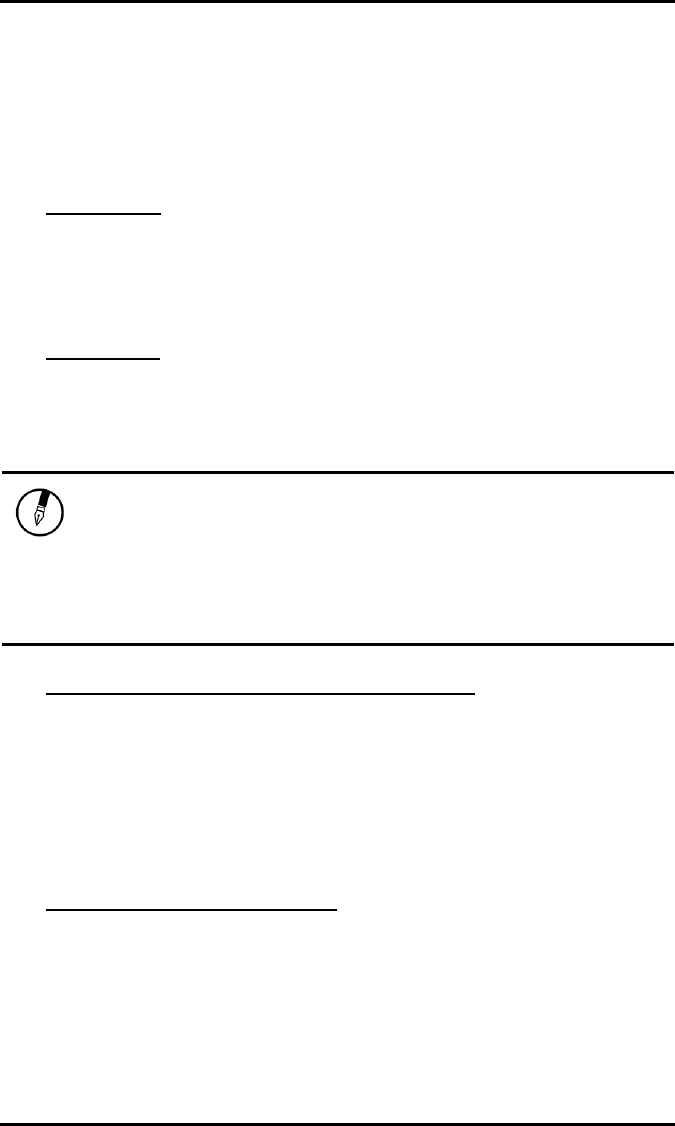
Chapter 3
23
The Graphics System
Your computer has a high-performance graphics system, which can easily
handle the demands of today's multimedia computing.
Screen Controls
Brightness
Function keys can increase or decrease the brightness of the monitor.
• <Fn> + <F6> decreases the LCD panel brightness
• <Fn> + <F7> increases the LCD panel brightness
Resolution
• Click My Computer/Control Panel/Display/Settings. Click the
Settings tab. The dialog box indicates the monitor resolution.
• Use the slide bar to adjust the resolution. Normally, you should
use the resolution the LCD or monitor was designed for.
Note: Using a lower resolution than the screen was designed for will
reduce the area of the display. Using the computer in DOS mode may
produce the same effect, because it uses a 640 by 480 resolution by
default. You can stretch these low resolution displays to full screen size
by selecting either the Expanded Display or Display Expansion Mode
features in the BIOS utility. However, the stretching may cause
distortion, especially to fonts.
High Resolution with an external monitor
Higher resolution modes may be used, as long as the monitor supports
them.
Connecting to an External Monitor
The notebook has a VGA monitor port to connect your computer to an
external monitor.
Using the VGA monitor port
• Locate the 15-pin VGA monitor port on the right side of your
notebook and connect the video signal cable from the external
monitor (or the VGA adapter) to the monitor port.
• Connect the power cable from the external monitor to a power
outlet and turn on the monitor.
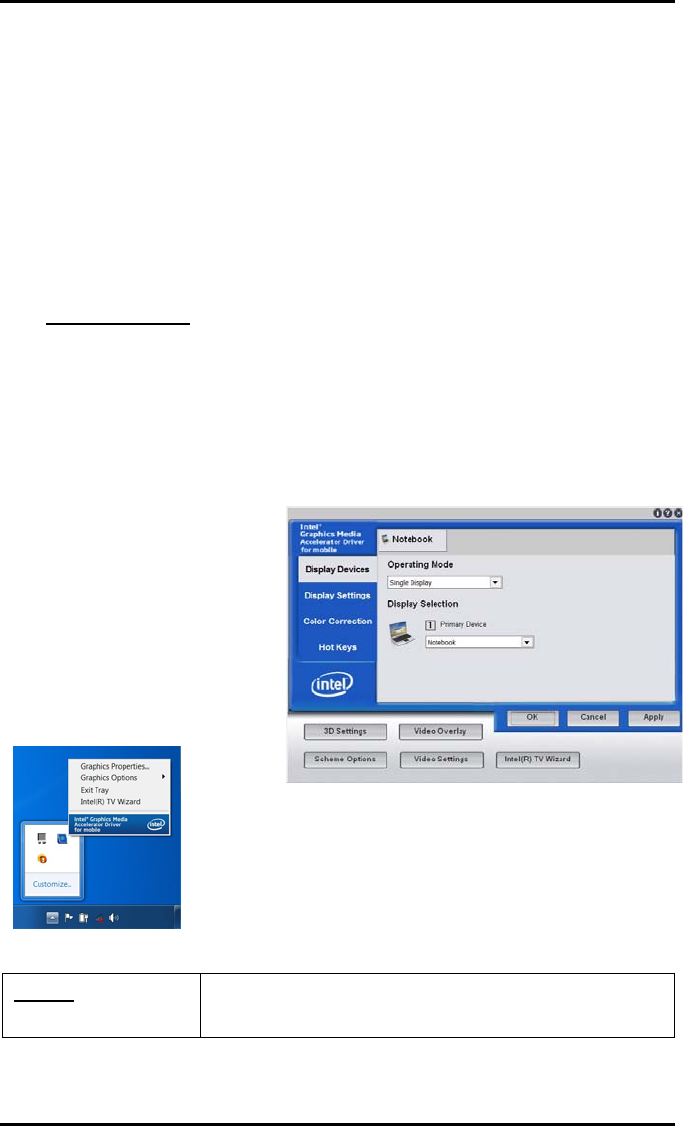
Chapter 3
24
• On your notebook, click the right touchpad button on the
Windows desktop to open the desktop menu. Click Properties to
open the Display Properties window.
• In the Display Properties window, click Advanced in the Settings
tab. Click the Display Modes tab.
• Under Driver mode, you can select the appropriate options to
change the display to an external monitor.
• Adjustments to screen resolution and color depth can also be
made in this dialog box.
Dual Displays
With Windows system, you may use an external monitor
simultaneously with your notebook’s LCD. You may also use the
external monitor only and disable the LCD or only use the LCD. To do
this you may first need to enable the multiple display settings in
Windows.
1. Click taskbar
Show hidden
icons
2. Choose Intel®
Graphics Media
Accelerator for
Mobile.
3. Click Graphic
Properties
4. Click the Settings
tab.
These options are described below.
Single You can choose which device to apply as the
Primary display.
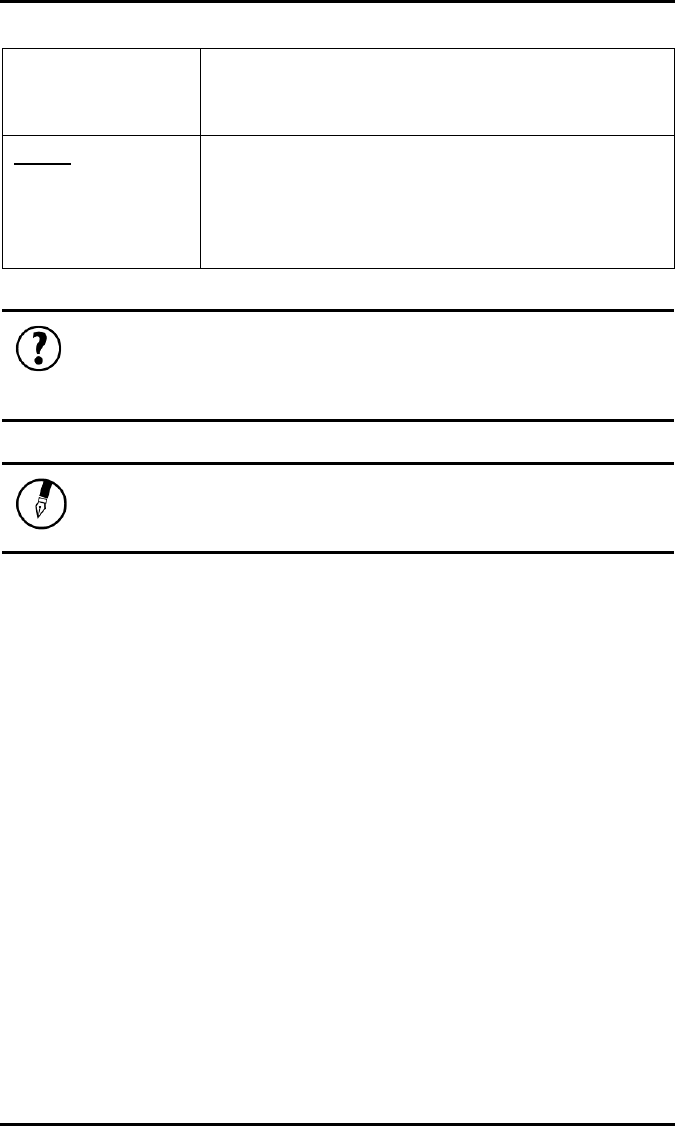
Chapter 3
25
In Single mode, the video display hot key
combination is available—you can cycle the video
output by pressing the Fn + F5 keys.
Mirror In Mirror mode, the video display hot key
combination is available—you can cycle the video
output by pressing the Fn + F5 keys.
If the external CRT is connected, the display on
the LCD and the CRT is the same.
Tip: To ensure trouble-free video output, the first time you use an
external monitor, change the output in the Display Properties dialog box.
After successfully switching modes, you may use the video function
keys.
Note: Light or dark dots may appear on the LCD due to technical
limitations of LCD manufacturing. This will not effect normal operation of
the LCD.
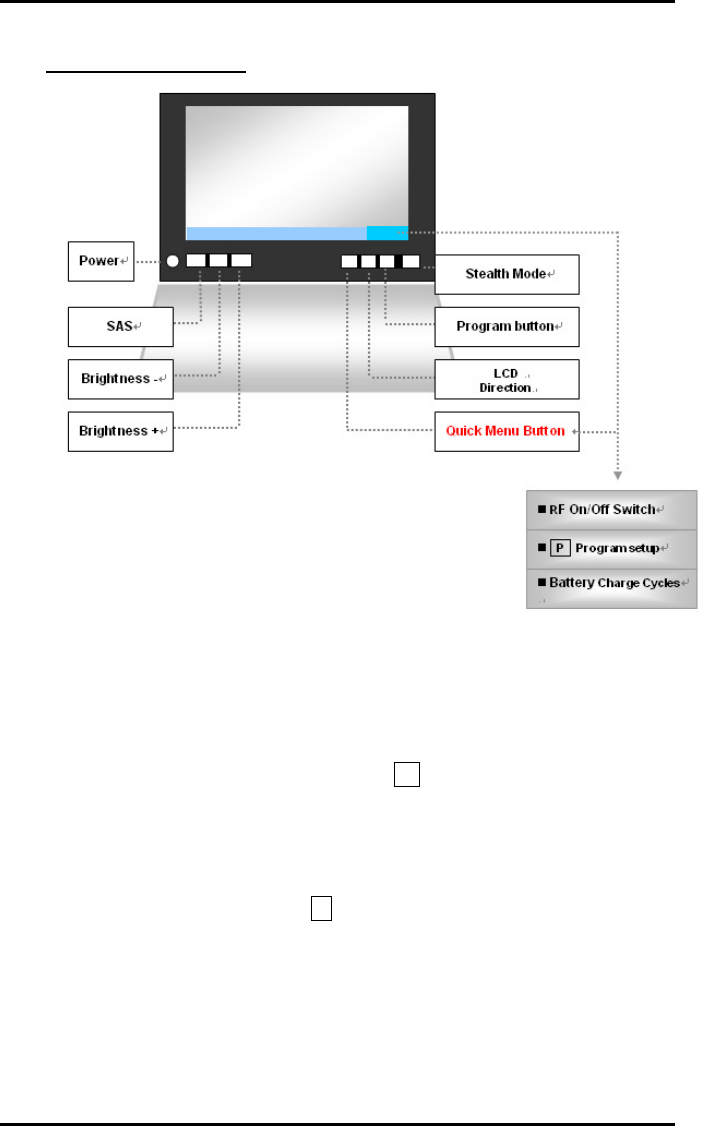
Chapter 3
26
Quick Menu & OSD
1. RF off, WLAN, WWAN, Bluetooth, GPS: When press RF off, all
of WLAN, WWAN, Bluetooth, GPS will stop working. If the user
wants to use Bluetooth, for example, just press “Bluetooth” again.
Note: WLAN and WWAN will not work in the same time
2. Program setup: Press the icon P on the quick menu, it will
popup a window that the user can choose programs. (Then, the
chosen program will link to program key (program button), when
the user press program button, the program can be used directly).
About program setting, use “path link” for use setting. Users can
press the setting up icon P and it can show program name.
Default: suggest to set up as: Windows Explorer
3. Battery charge cycles: shows charge cycles of each battery.
When battery does not exist, the battery icon will become “gray”.
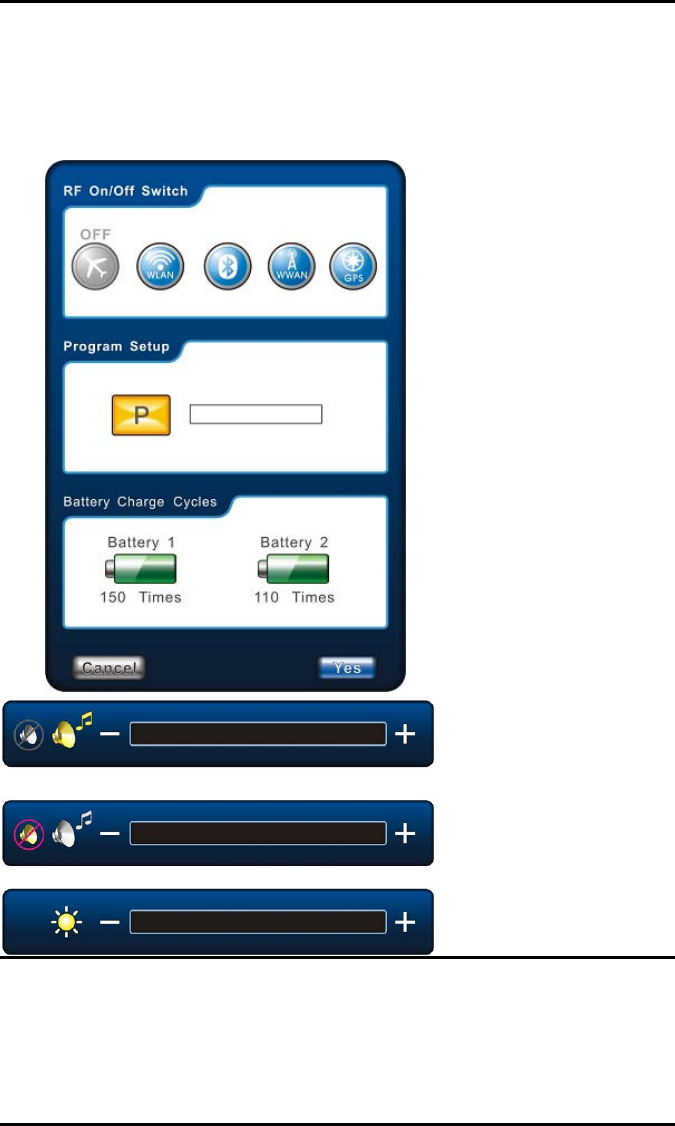
Chapter 3
27
OSD
Indicate the status of brightness and volume
The OSD will show up for 5 secods after the button or key is pressed.

Chapter 3
28
C
Ch
ha
ap
pt
te
er
r
3
3
M
Ma
ak
ki
in
ng
g
C
Co
on
nn
ne
ec
ct
ti
io
on
ns
s
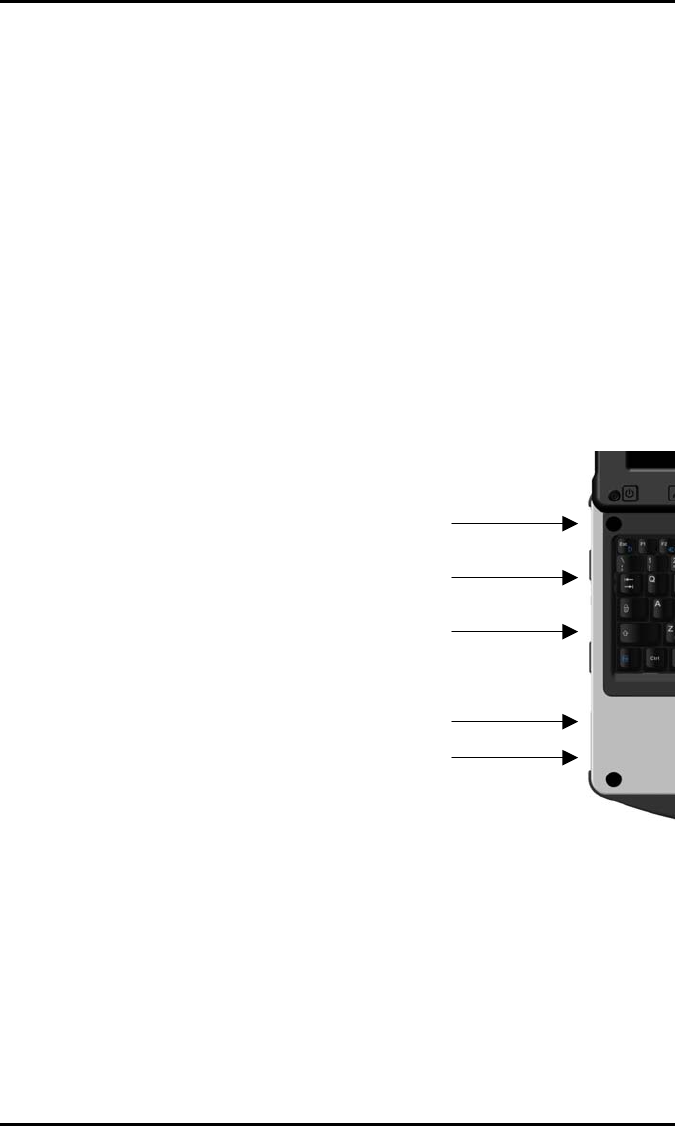
Chapter 3
29
1
2
3
4
5
Making Connections
Your computer is equipped with a full array of ports and connectors,
including standard input/output (I/O) ports for quickly and easily adding
peripheral devices such as printers, keyboards, and mice. Refer to
documentation included with individual devices for details on
connecting these devices to your computer. Along with the standard
ports found on most computers, your computer also includes IEEE
1394 ports, modem and LAN ports, offering advanced communications
technology.
Left Side Connectors
1. USB 2.0(Universal Serial Bus) Ports
The Universal Serial Bus (USB) is the latest standard for attaching
monitors, input devices, scanners, and other devices to a PC. USB
devices can be chained together on a single cable.
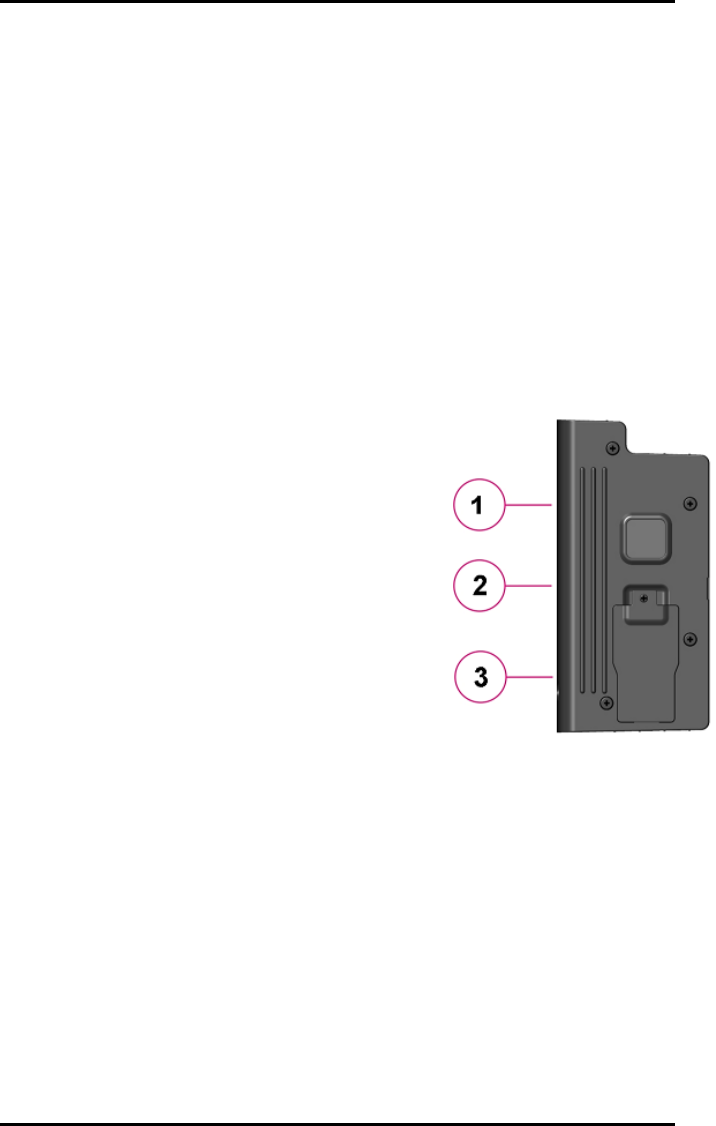
Chapter 3
30
2. e-SATA/USB 2.0 combo Ports
3. SDHC Card Reader
4. Audio-out Jack
Connect a stereo headset or external speakers to this jack to
listen to multimedia.
5. Microphone-in Jack
Connect a microphone to this jack to record.
Right Side Connectors (Optional)
1. & 3. Optical USB 2.0
The Universal Serial Bus (USB) is the latest
standard for attaching monitors, input
devices, scanners, and other devices to a
PC. USB devices can be chained together
on a single cable.
2. D-sub serial port
The D-sub serial port provides the
connection for RS232 interface device.
Other Optional I/O Modules
I/O module 2: USB 2.0 x1, Smart card reader x1
I/O module 3: WWAN 3G module that support HSDPA/EVDO or Gobi
2000 module or GPS mini card module, Support Ext. antenna
connector
I/O module 4: Optional 2nd 2M pixel auto-focus camera module
The optional I/O module can be access for CTO purpose by removing
the door on the lower cover.
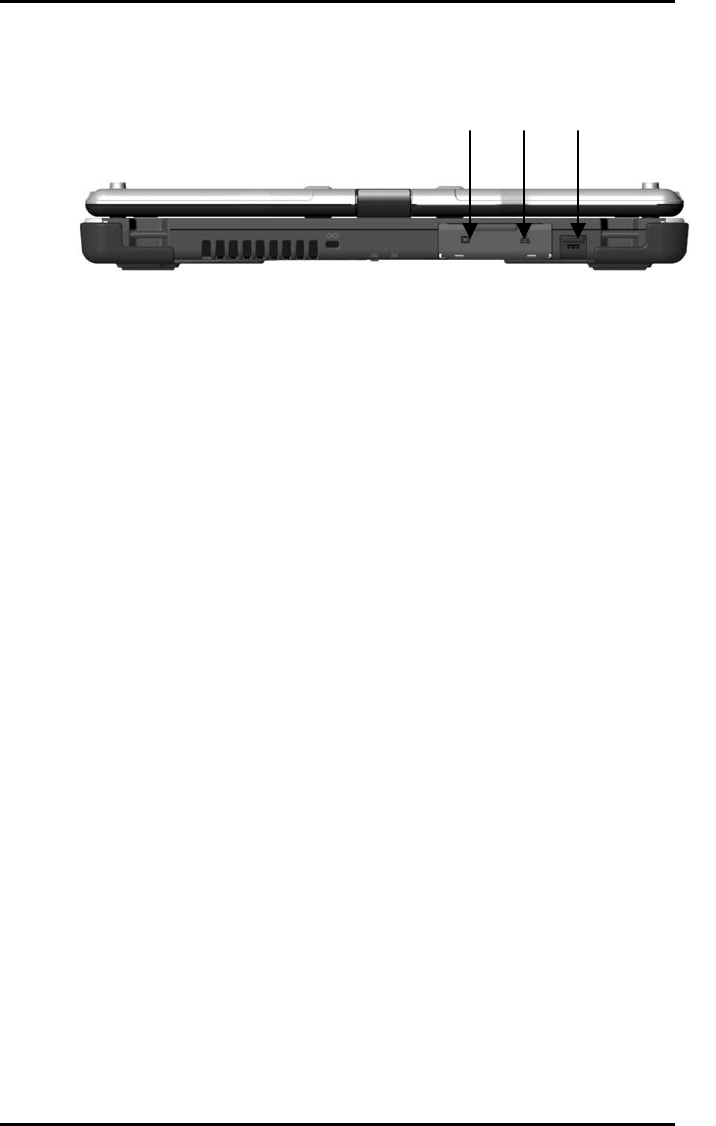
Chapter 3
31
1 2 3
Rear Side Connectors
1. VGA Out (External Video) Port
The 15-pin VGA port can be used to connect your computer to an
external monitor. (See the Graphics System in chapter 2 for more
information).
2. LAN RJ-45 Jack
With the built-in Ethernet LAN combo, you can make LAN connections.
Connection speed is up to 1000 Mbps.
3. DC-in Jack
Connect the DC power cable from the AC adapter to this jack.

C
Ch
ha
ap
pt
te
er
r
4
4
P
Po
ow
we
er
r
M
Ma
an
na
ag
ge
em
me
en
nt
t

Chapter 4
33
Power Management
Battery Calibration
The first time you use a battery, you should calibrate it. The calibration
process empties and charges the battery one time. This allows the
Windows battery gauge to accurately monitor battery status. To
calibrate a battery, follow these steps:
1. Plug in the AC adapter.
2. Restart the computer and when the startup screen appears,
press Del key to enter the BIOS Setup Utility.
3. In the BIOS Setup Utility, select Advance settings, choose
Battery calibration, and then press enter.
Battery Calibration will take from 4 to 8 hours, depending on how
much power the battery may already contain.
Note: For optimum performance, we recommend calibrating the
battery again every three months. Each time you charge and
discharge a battery, it loses a tiny part of its storage capacity, so that,
over time, it will store less than its potential charge. Similarly, if you
do not use the battery for a few days, it will slowly self-discharge, and
when it is recharged, it will hold less than 100% of the potential
charge.
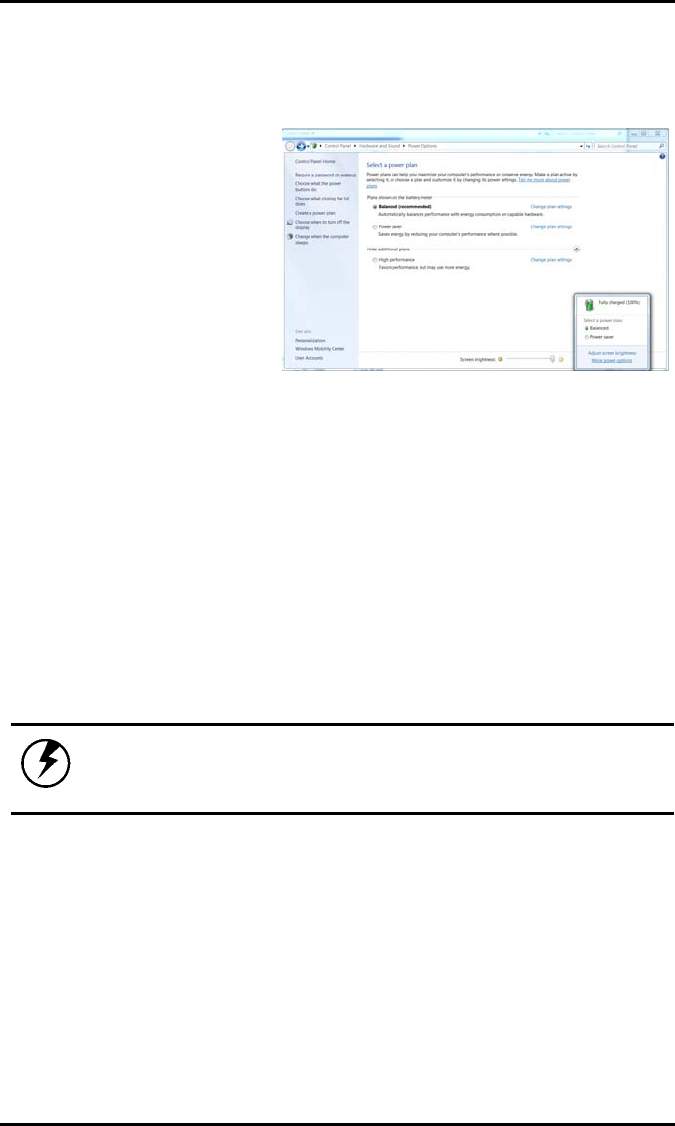
Chapter 4
34
Monitoring Battery Power
There are two ways to
monitor how much power
the battery has left.
1. Click start/Control
Panel/Power Options;
then click Power Meter.
2. Moving the cursor to
the battery icon on the
taskbar is the simplest
way to check on battery
power status.
If you do not see the battery icon, enable it in Start /Control Panel/Power
Options. Choose the Advanced tab and click “Always show icon on the
taskbar.”
Low Battery Alarms
How your computer responds to a low battery condition is set under
Start/Control Panel/Power Options/Alarms.
Two different power alarms can be enabled or disabled: the Low
Battery Alarm, and the Critical Battery Alarm. Use the slide bar to set
the power level at which the alarms are activated. Click on the Alarm
Action button to choose whether the alarm sounds, displays a
message, or both.
Warning: When battery power is low, the Notebook will display a
warning on the screen. Take immediate action, such as saving files or
connecting to the AC adapter, or data may be lost.
When the computer alerts you that the battery is low, immediately do
one of the following:
• Connect the AC power adapter
• Save your work, turn off the computer and replace the
discharged battery with a charged battery (See Changing the
Battery below).
Do not restart the computer until you have connected to an AC
adapter, or replaced the discharged battery with a charged battery.

Chapter 4
35
Battery Charging
When you use the AC adapter to connect your Notebook to a power
outlet, the internal battery will automatically begin to recharge. While
the battery is charging, the Battery Charge icon on the Indicator panel
will be active. When the battery is fully charged, the Battery Charge
icon will turn off.
If your computer is turned off or standby mode, a fully discharged
battery will take about 3 hours to recharge.
Power Saving Modes
Adjust the default power management settings in the Power Options/
Advanced dialog box in the Control panel. The Power Options
Properties dialog box allows you to set different actions to take when
the computer is left idle for a certain amount of time.
Suspend Mode
There are several possible settings for suspend mode, which can be
selected in the Power Management dialog box: You may have the
notebook standby, suspend, or you can power off the computer
altogether.
Initiating Suspend Mode
There are four ways to initiate suspend mode. The settings can be
adjusted in the Power Management dialog box:
• The computer will automatically enter suspend mode when not
used for a set period of time.
• Selecting the Stand by button in the Shut down Windows dialog
box.
• Closing the screen cover (assuming no external monitor has
been connected).
• Pressing the power button (if enabled in power settings).
• Pressing the suspend function key <Fn> + <F4>.

Chapter 4
36
Power Button Settings
The function of the power button can be set to Shutdown or Standby in
the Power Management Properties dialog box in the Windows Control
Panel. However, holding the power button down for more than four
seconds will force a power off while operating under any situation,
resulting in the loss of any unsaved information.
Power Saving Tips
• Avoid operating the audio and video applications when using
battery power. Operating a video or audio equipment increases
the computer's power requirements.
• Decreasing monitor brightness can also save power. Decrease
brightness by pressing hot key “Brightness down”. Increase it by
pressing hot key “Brightness up”.
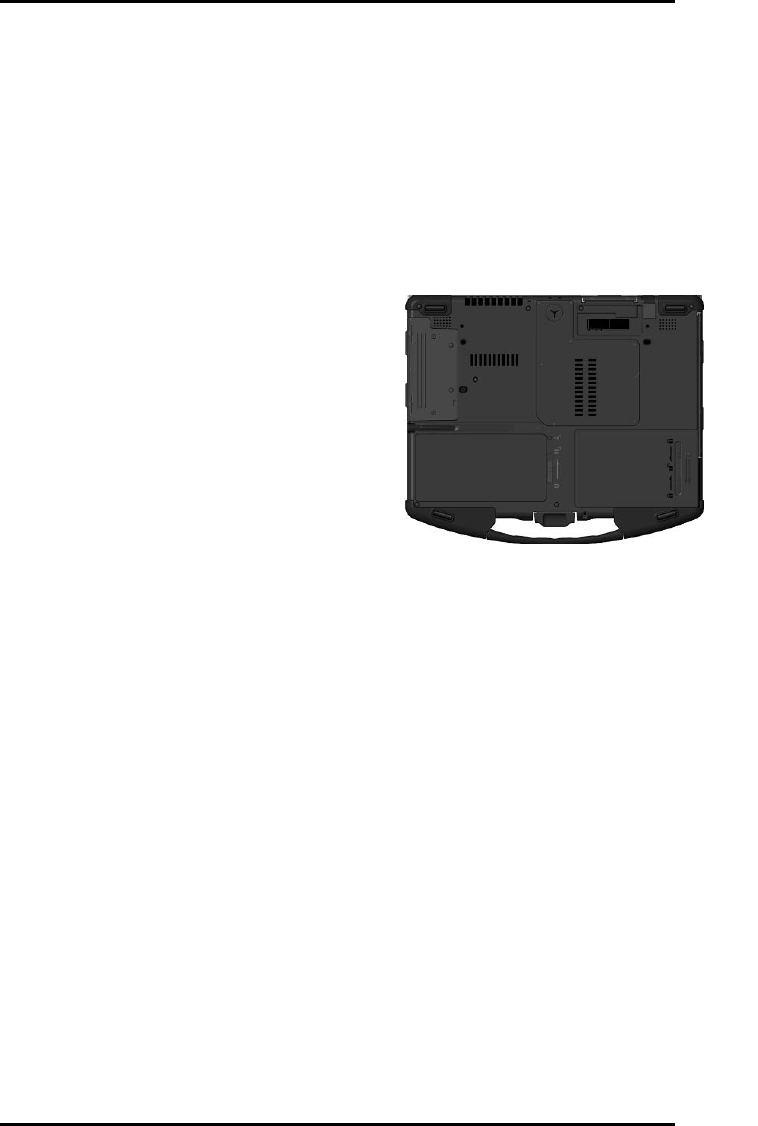
Chapter 4
37
When to Replace the Battery
Over time, the battery's capacity gradually decreases. We recommend
that you replace your battery when you notice that it begins to store
significantly less charge.
Changing the Battery
Change the main battery pack as
follows:
3. Turn off the computer.
4. Close the screen cover and turn the
computer over.
5. Slide the side battery latch away
from the battery. Continue to hold it
until the battery is removed.
6. Remove the battery.
7. Make sure the replacement battery
is properly orientated. Slide back the
side battery latch then insert the
battery into the battery
compartment. Check that the latch
locks back into position.
Heat Considerations
The computer's processor has been specially designed to consume
little power, and generates very little heat. However, working in a hot
environment, or working for long periods may raise the temperature.
Your computer takes the following steps to lower temperature:
• The cooling fan will automatically turn on. You may feel air
coming from a vent at the left side when this happens.
• If the temperature continues to rise, processor activity will be
reduced. You may notice a slight loss of performance when this
happens.

Chapter 4
38
Warning:
1. It is better to charge the system for 16 hours or longer when
users receive the system at the first time.
2. Please remove AC adapter first, and then replace main
battery after system entering into S3 mode (suspend to RAM).
3. Please make sure all USB devices are removed when users
replace main battery in S3 mode (suspend to RAM).

Chapter 5
39
C
Ch
ha
ap
pt
te
er
r
5
5
U
Us
si
in
ng
g
t
th
he
e
B
BI
IO
OS
S
S
Se
et
tu
up
p
U
Ut
ti
il
li
it
ty
y

Chapter 5
40
U
Us
si
in
ng
g
t
th
he
e
B
BI
IO
OS
S
S
Se
et
tu
up
p
U
Ut
ti
il
li
it
ty
y
Your notebook has a BIOS setup utility which allows you to configure important system
settings, including settings for various optional functions of the computer. This chapter
explains how to use the BIOS setup utility.
BIOS Setup Menu
The setup uses a menu interface to allow the user to configure their system. The features
are
MAIN: Allows the user to specify system time and system date and the system overview.
Advanced: Allows the user to set BIOS function .
Boot: Allow the user to set the boot sequence
Security: Allows the user to set the password for system.
Exit: Exit option
Main Menu
Aptio SETUP UTILITY
Main Advanced Boot Security Exit
BIOS Information
BIOS Version R1.00
Build Date 01/09/2010
EC Version 3.32.0
ME Version 6.1.1.10.1052
UUID 00020003000400050006000700080009
Serial Number 1234567890
Processor Information
Type Intel(R) Core(TM) i5 CPU U 540 @ 1.20GHz
Speed 1197MHz
Memory Information
Total Memory 4096 MB (DDR3 800)
System Date [Sat 02/20/2010]
System Time [19:14:50]
Version 2.00.1201. Copyright © 2009 American Megatrends, Inc.

Chapter 5
41
System Time (hh/mm/ss) :
System Date ( week mm/dd/yyyy) :
Allows the user to set the time and date.
The Time is displayed in 24 hours format.
The Date can be set from January 1st, 1980 to December 31, 2099
The values set in these two fields take effect immediately.
Advanced Menu
Aptio SETUP UTILITY
Main Advanced Boot Security Exit
Advanced Setting
SATA Mode [AHCI Mode]
FAN Calibration
Battery Calibration
Wake on LAN from S4/S5 mode [Disable]
Bluetooth [Disable]
WLAN [Disable]
WWAN [Disable]
GPS [Disable]
Trusted Computing
Options
(1) IDE Mode. (2) AHCI Mode.
←→ Select Screen
↑↓ Select Item
+- Change Option
F1 General Help
F10 Save and Exit
ESC Exit
Version 2.00.1201. Copyright © 2009 American Megatrends, Inc.
FAN Calibration :
Allows user to Start Fan Learning.
[Enter]

Chapter 5
42
Default is “Enter”.
Battery Calibration:
Allows user to Start Battery Learning.
[Enter]
Default is “Enter”.
Boot Menu
Aptio SETUP UTILITY
Main Advanced Boot Security Exit
Boot Option Priorities
Boot Option #1 [P0: TOSHIBA MK50..]
Boot Option #2 [Built-in EFI Shell]
Boot Option #3 [Realtek PXE B02..]
Hard Drive BBS Priorities
Network Device BBS Priorities
Set the system boot order
←→ Select Screen
↑↓ Select Item
+- Change Option
F1 General Help
F10 Save and Exit
ESC Exit
Version 2.00.1201. Copyright © 2009 American Megatrends, Inc.
Boot Option #1
Allow the user to select 1st boot device.
[HDD]
[CD/DVD]
[Network]

Chapter 5
43
[Disabled]
Default is “HDD”.
Boot Option #2
Allow the user to select 2nd boot device.
[HDD]
[CD/DVD]
[Network]
[Disabled]
Default is “CD/DVD”.
Boot Option #3
Allow the user to select 3rd boot device.
[HDD]
[CD/DVD]
[Network]
[Disabled]
Default is “Network”.

Chapter 5
44
Security Menu
Aptio SETUP UTILITY
Main Advanced Boot Security Exit
Password Description
If ONLY the Administrator’s password is set,
Then this only limits access to Setup and is
Only asked for when entering Setup
If ONLY the User’s password and must be entered to
Boot or enter Setup. In Setup the User will
Have Administrator rights
Administrator Password
User Password
Set Setup Administrator
Password
←→ Select Screen
↑↓ Select Item
Enter Change
F1 General Help
F10 Save and Exit
ESC Exit
Version 2.00.1201. Copyright © 2009 American Megatrends, Inc.

Chapter 5
45
Exit Menu
BIOS SETUP UTILITY
Main Advanced Boot Security Exit
Exit Options
Save Changes and Exit
Discard changes and Exit
Discard Changes
Load Optimal Defaults
Exit system setup
after saving the changes.
F10 key can be used for this operation.
←→ Select Screen
↑↓ Select Item
Enter Go To Sub Screen
F1 General Help
F10 Save and Exit
ESC Exit
V02.65 ©Copyright 1985-2004, American Megatrends, Inc.

A
Ap
pp
pe
en
nd
di
ix
x
A
A
I
In
ns
st
ta
an
nt
t
R
Re
ec
co
ov
ve
er
ry
y
S
So
of
ft
tw
wa
ar
re
e
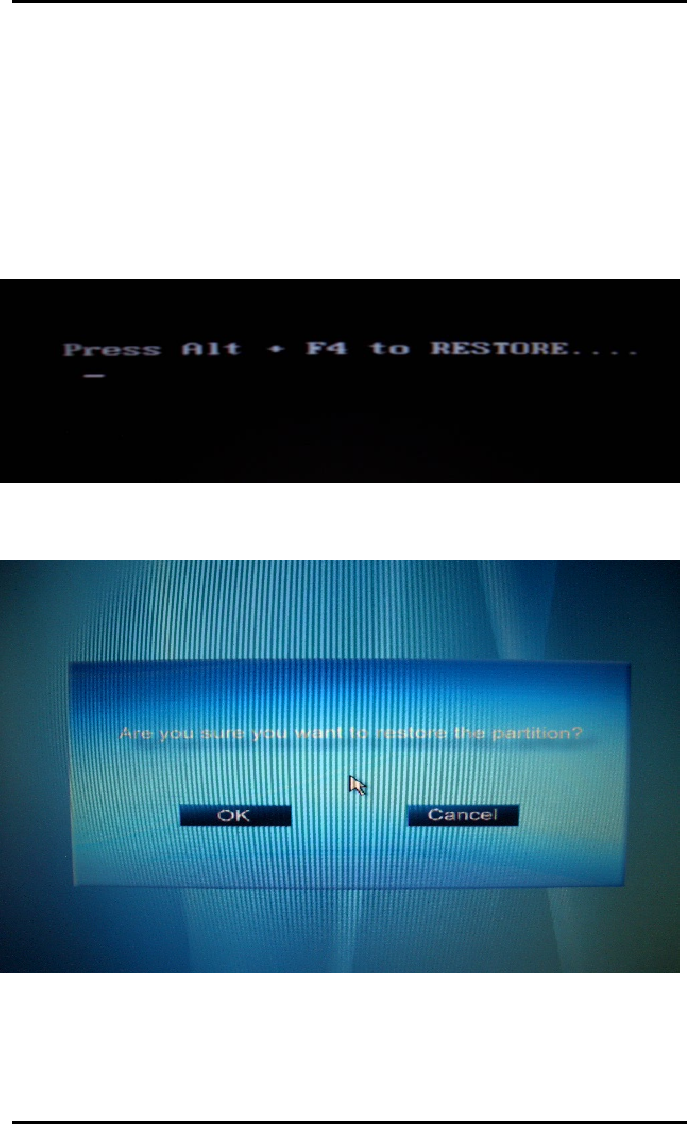
Appendix B
47
Instant Recovery Software
No need to locate a recovery CD to restore your software settings, it is
already pre-installed on your notebook hard drive. Simply follow the steps
below and restore your notebook to the original factory settings.
1. Press power button boot System,then press Alt+F4 to start the
recovery
2. “Are you sure you want to restore the partition?” Please click ”OK”
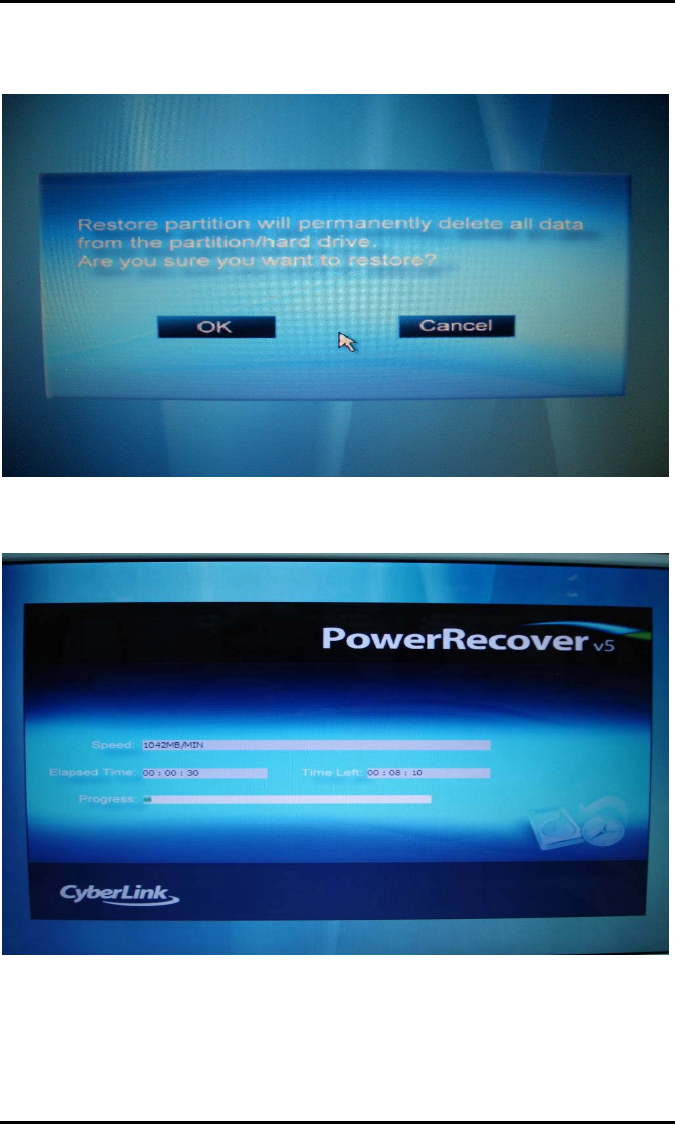
Appendix A
48
3. Warning message for double confirmation,please click “OK”
4. Start to recover system
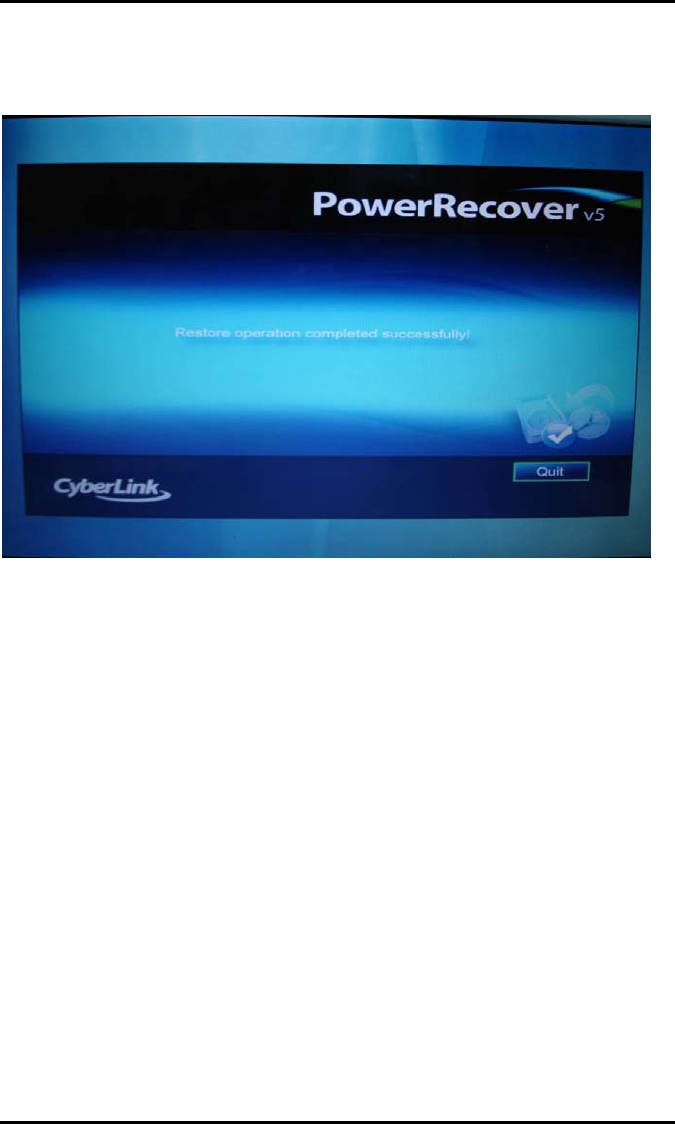
Appendix B
49
5. Restore operation completed, please click “Quit” to finish all of the
recovery procedure

A
Ap
pp
pe
en
nd
di
ix
x
B
B
F
FA
AQ
Q
&
&
S
St
ta
at
te
em
me
en
nt
t

Appendix B — FAQ & Statement
61
Frequently Asked Questions
Q: My screen seems to time out too quickly. I have to constantly
hit a key or move the mouse in order to bring it back. How can
I adjust the screen time-out?
A: This is part of Windows Power Management. Access Power
Management by clicking on Start / Settings / Control Panel /
Power Management. Adjust the display time-out by selecting a
time next to the Turn off monitor option. You may also select
different time-out values for adapter and battery power states.
Q: I've heard that cleaning up and rearranging files on the hard
drive will improve the startup speed of my programs. How do I
do this?
A: Hard disk maintenance can improve the startup speed of programs.
This maintenance includes deleting unnecessary files, and
defragmenting, which rearranges data into more efficient groupings.
Windows includes utilities for performing these maintenance tasks.
Run Disk Cleanup to remove unnecessary files, and Disk
Defragmenter to defragment the hard drive. For more information,
refer to Windows documentation.
Q: What kind of external microphone can I use with my notebook
computer?
A: You will need to use a self-amplifying microphone.
Q: There is feedback noise coming from my speakers. What can I
do?
A: Double click on the Speaker icon on the task bar. Then, under
Microphone Balance, check the Mute box.
Q: Because of a software problem, I was unable to shut down
power normally. I pressed the power button to force a power
off, but it didn't work. How can I force a power off?
A: Make sure you press the power button for at least 4 seconds.
Normally, this will force a power off. If this does not work, you can

Appendix B — FAQ & Statement
62
shut down the computer by inserting a needle into the reset button
pinhole. (The reset button locates on the computer bottom side.)
Q: Why can’t I charge the battery of my portable computer after it
was out of use for some time?
A: After portable computers have not been used for a long time (more
than one month), the batteries will go into the low voltage
protection mode due to data back-ups and natural electrical
discharge. At that point, restoring normal voltage will require slow
charging over a period of several hours. Calibration can be
performed after the battery has returned to a normal condition.
Q: My computer alerts “CMOS Battery Low”, what can I do?
A: If you keep your computer in no power situation (unplug the
computer from the power outlet and remove battery at the same)
over 45 days, your data in CMOS will be lost.
Please reconfigure your CMOS by following steps:
1. Press DEL or F2 to enter the BIOS setup utility.
2. Select “Restore Defaults?” When you see the following
prompt, choose <Yes> and then press <Enter>.
Load Optimized Defaults?
[Yes] [No]
3. Select “Save Changes and Exit”. When you see the
following prompt, choose <Yes> and then press <Enter> to
restart your computer.
Save configuration and exit?
[Yes] [No]

Appendix B — FAQ & Statement
63
Statements
Federal Communications Commission Statement
This equipment has been tested and found to comply with the limits for
a Class B digital device, pursuant to Part 15 of the FCC Rules. These
limits are designed to provide reasonable protection against harmful
interference in a residential installation. This equipment generates,
uses, and can radiate radio frequency energy and, if not installed and
used in accordance with the instructions, may cause harmful
interference to radio communications. However, there is no guarantee
that interference will not occur in a particular installation. If this
equipment does cause harmful interference to radio or television
reception, which can be determined by turning the equipment off and
on, the user is encouraged to try to correct the interference by one or
more of the following measures:
Reorient or relocate the receiving antenna.
Increase the separation between the equipment and the receiver.
Connect the equipment into an outlet on a circuit different from that
to which the receiver is connected.
Consult the dealer or an experienced radio/TV technician for help.
Shielded interconnect cables and shielded AC power cable must be
employed with this equipment to insure compliance with the pertinent
RF emission limits governing this device. Changes or modifications not
expressly approved by the system's manufacturer could void the
user's authority to operate the equipment.
RF exposure warning
This equipment must be installed and operated in accordance with
provided instructions and must not be co-located or operating in
conjunction with any other antenna or transmitter. End-users and installers
must be provide with antenna installation instructions and transmitter
operating conditions for satisfying RF exposure compliance.
SAR Value: 0.150 W/kg
Industry Canada Warnings
Operation is subject to the following two conditions: (1) this device
may not cause interference, and (2) this device must accept any
interference, including interference that may cause undesired
operation of the device.

Appendix B — FAQ & Statement
64
European Notice
Products with the CE Marking comply with both the EMC Directive
(89/336/EEC) and the Low Voltage Directive (73/23/EEC) issued by
the Commission of the European Community.
Compliance with these directives implies conformity to the following
European Norms:
EN 55022 ( CISPR 22 ) Radio Frequency Interference
EN 55024 ( EN61000-4-2, EN61000-4-3, EN61000-4-4,
EN61000-4-5, EN61000-4-6, EN61000-4-8,EN61000-4-11,
EN61000-3-2, EN61000-3-3 ) Generic Immunity Standard
EN 60950-1 ( IEC 60950-1 ) Product Safety
R&TTE (CE) MANUAL REGULATORY REQUIREMENT
(WLAN - IEEE 802.11b/g)
802.11b Restrictions:
European standards dictate maximum radiated transmit power
of 100mW EIRP and frequency range 2.400-2.4835GHz.
In France, the equipment must be restricted to the 2.4465-
2.4835GHz frequency range and must be restricted to indoor
use."
CE Declaration of Conformity
CE 0984 !
Is herewith confirmed to comply with the requirements set out in the
Council Directive on the Approximation of the Laws of the Member
States relating to Electromagnetic Compatibility (89/336/EEC), Low-
voltage Directive (73/23/EEC) and the Amendment Directive
(93/68/EEC), the procedures given in European Council Directive
99/5/EC and 89/3360EEC.

Appendix B — FAQ & Statement
65
The equipment was passed. The test was performed according to the
following European standards.
EN 300 328 V1.7.1 (2006-05)
EN 301 489-1 V.1.4.1 (2005-09) / EN 301 489-17 V.1.2.1 (2002-
04)
EN 50371:2002
EN 60950-1:2001
SAFETY CAUTION
To reduce the risk of fire, use only No. 26 AWG or larger
telecommunication line cord.
IMPORTANT SAFETY INSTRUCTIONS
When using your telephone equipment, basic safety precautions
should always be followed to reduce the risk of fire, electric shock and
injury to persons, including the following:
Do not use this product near water, for example, near a bathtub, wash
bowl, kitchen sink or laundry tub, in a wet basement or near a
swimming pool.
Avoid using a telephone (other than a cordless type) during an
electrical storm. There may be a remote risk of electric shock from
lightning.
Do not use the telephone to report a gas leak in the vicinity of the leak.
Use only the power cord and batteries indicated in this manual. Do not
dispose of batteries in a fire. They may explode. Check with local
codes for possible special disposal instructions.
Canadian Department of Communications
This class B digital apparatus meets all requirements of the Canadian
Interference-causing Equipment Regulations.

Appendix B — FAQ & Statement
66
Battery Disposal
THIS PRODUCT CONTAINS A LITHIUM-ION OR NICKEL-METAL
HYDRIDE BATTERY. IT MUST BE DISPOSED OF PROPERLY.
CONTACT LOCAL ENVIRONMENTAL AGENCIES FOR
INFORMATION ON RECYCLING AND DISPOSAL PLANS IN YOUR
AREA.
CAUTION FOR ADAPTER
THIS NOTEBOOK COMPUTER IS FOR USE WITH DEDICATED
AC Adapter.
BATTERY CAUTION
DANGER OF EXPLOSION IF BATTERY IS INCORRECTLY
REPLACED.
REPLACE ONLY WITH THE SAME OR EQUIVALENT TYPE
RECOMMENDED BY THE MANUFACTURER. DISPOSE OF USED
BATTERIES ACCORDING TO THE MANUFACTURER'S
INSTRUCTIONS.
CLASS 1 LASER PRODUCT
LASERSCHUTZKLASSE 1 PRODUKT TO EN60825
CAUTION: THIS APPLIANCE CONTAINS A LASER SYSTEM AND IS
CLASSIFIED AS A "CLASS 1 LASER PRODUCT.” TO USE
THIS MODEL PROPERLY, READ THE INSTRUCTION MANUAL
CAREFULLY AND KEEP THIS MANUAL FOR FUTURE
REFERENCE. IN CASE OF ANY TROUBLE WITH THIS
MODEL, PLEASE CONTACT YOUR NEAREST "AUTHORIZED
SERVICE STATION.” TO PREVENT DIRECT EXPOSURE TO
THE LASER BEAM, DO NOT TRY TO OPEN THIS
ENCLOSURE.

Appendix B — FAQ & Statement
67